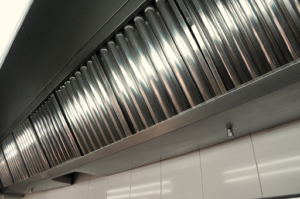A properly designed, installed and functional ventilation system is critical for building fire safety. It is required to remove smoke odors and grease laden vapors from the cooking area to the exterior of the building. For this reason, it is imperative that the system is operating during all cooking periods and should operate for a minimum of 15 minutes after cooking has stopped.
Below are recommendations for optimal ventilation system performance.
- Ventilation systems should be constructed of stainless steel rather than galvanized or aluminum, which are cheaper but do not provide sufficient protection in a fire event.
- All seams should be externally welded to prevent grease from escaping and the hood should cover all cooking appliances.
Insufficient clearance between the hood and ductwork to surrounding combustible building
members, creates a severe fire hazard. Over time, high heat levels can lower the ignition
temperature of wood to combustible walls, ceilings, roofing members, etc. This can be
mitigated by increasing the air space between the metal duct/hood and the frame building
members, utilizing mineral wool insulation or installing stainless steel on spacers or
insulation. NFPA 96 should be consulted for guidance.
Fans should be mounted on the exterior of the building and cleaned on a regular basis.
Their exact location is governed by the building construction and NFPA requirements, which
include fan clearance to doors, windows, roof slope clearance, etc.
Place baffles in the hood area to minimize the amount of grease that is drawn into the
duct system. They should be of stainless-steel construction, installed at a 45° angle and
must be tight fitting. Baffles and grease trays should be cleaned daily. Older systems utilize
galvanized baffles or mesh type grease filters. Grease filters should be replaced with up to
code stainless steel baffles as they absorb grease, creating a fire hazard.

There are an estimated 5,600 restaurant fires reported annually, resulting in over $116M in property damage. *
Common Causes of Fires in Restaurants**
- Cooking Equipment is responsible for 57% of restaurant fires.
- Heating Equipment is responsible for 10% of restaurant fires.
- Electrical distribution and lighting equipment is responsible for 7% of restaurant fires
- Smoking is responsible for 7%
- Arson is responsible for 5%
- Failure to keep a clean kitchen was a factor in approximately 22% of fires
* National Fire Incident Reporting System (NFIRS)
** National Fire Protection Association (NFPA)
Includes content provided by Mutual Boiler Re
Hospitality Insurance Group
106 Southville Road, Southborough, MA 01772
www.hmic.com
877-366-1140
